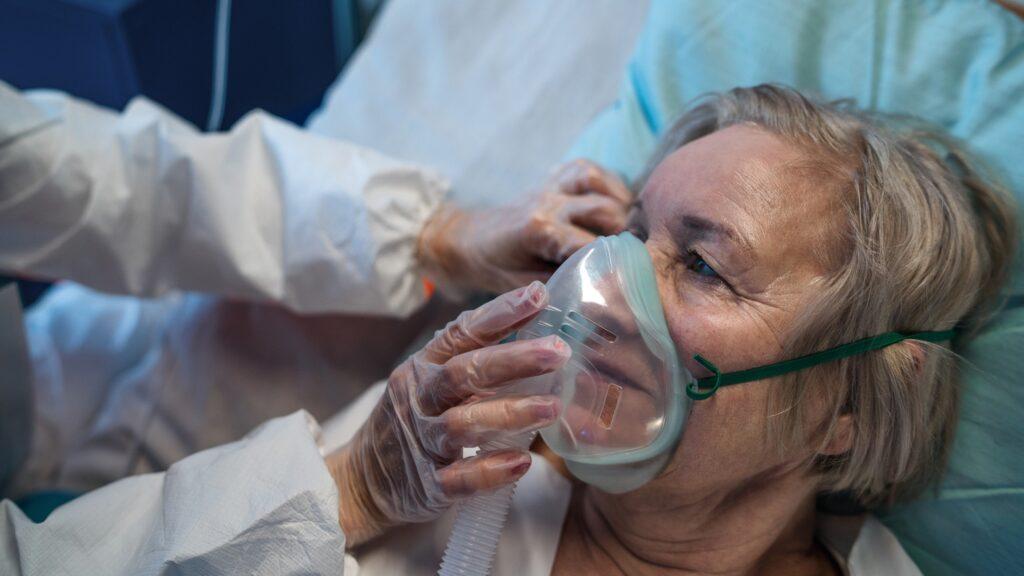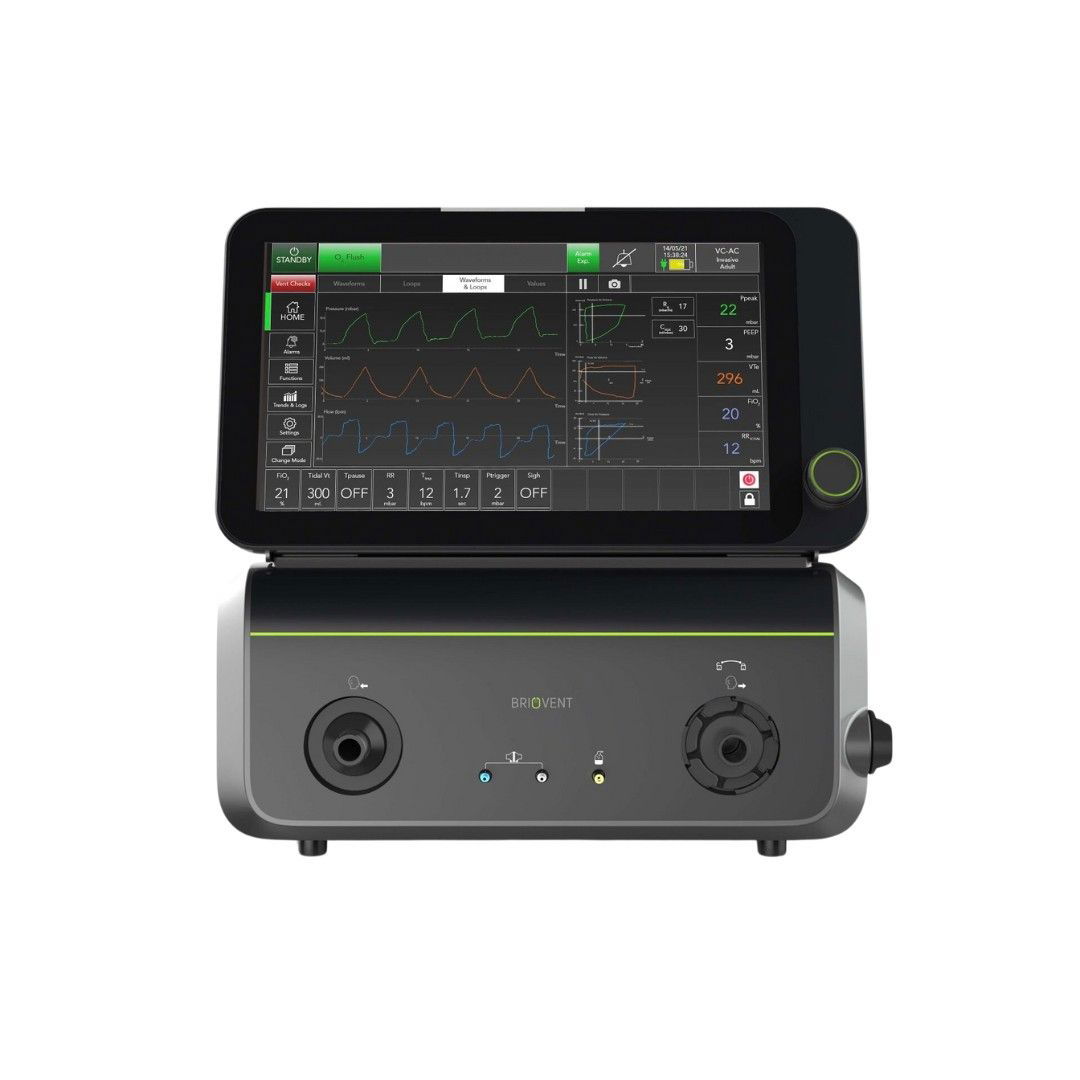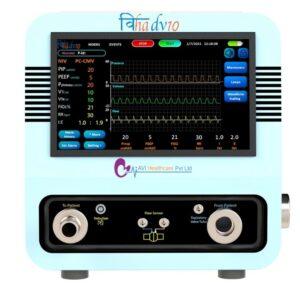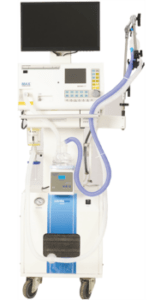In the realm of modern medicine, Medical Ventilators play a pivotal role in providing critical respiratory support to individuals with compromised breathing. These sophisticated devices have transformed the landscape of patient care, offering life-saving interventions for those battling respiratory conditions. Whether it’s invasive ventilators that require a more direct approach or non-invasive options that offer gentler support, these devices have become essential tools in healthcare settings worldwide. This blog aims to unravel the intricacies of medical ventilators, shedding light on their functionalities, benefits, and importance in various medical scenarios. We will explore the world of invasive and non-invasive ventilators, understanding how they work and the conditions they address. Additionally, we will delve into the realm of portable ventilators, exploring their mobility and convenience for patients on the move.
Understanding Invasive Ventilators
Invasive ventilators are vital life-support devices used in medical settings to assist patients who are unable to breathe adequately on their own. These machines deliver pressurized oxygen directly into the patient’s lungs through an inserted airway tube. These ventilators allow healthcare professionals to control and adjust parameters such as tidal volume, respiratory rate, and positive end-expiratory pressure (PEEP).
To initiate invasive ventilation, healthcare professionals carefully select the appropriate size and type of airway tube and secure its insertion into the patient’s airway. However, invasive ventilation carries certain risks, including infections and ventilator-associated lung injury. Therefore, close monitoring, adherence to infection control measures, and regular assessment of respiratory parameters are essential. In summary, invasive ventilators provide crucial respiratory support by delivering pressurized oxygen through an inserted airway tube. They are extensively used in critical care settings to assist patients with severe respiratory conditions. With advanced features and continuous monitoring, invasive ventilators play a critical role in managing critically ill patients and optimizing their respiratory function.
Exploring Non-Invasive Ventilators
Non-invasive ventilators utilize interfaces like masks or nasal prongs to deliver pressurized air or oxygen to the patient’s airway. Patients experience increased comfort, better mobility, and improved quality of life compared to invasive ventilation. Portable non-invasive ventilators have added convenience and mobility to respiratory support. They enable patients with chronic respiratory conditions to engage in daily activities while receiving necessary ventilatory support. These devices incorporate advanced features for monitoring and adjusting ventilation parameters to optimize patient comfort and ventilation effectiveness. Continuous monitoring of vital signs allows healthcare providers to assess the effectiveness of non-invasive ventilation and make necessary adjustments. While non-invasive ventilation has shown success in preventing the need for intubation and reducing complications, patient suitability depends on factors like the severity of respiratory distress and patient cooperation.
Portable Medical Ventilators
Portable ventilators have revolutionized respiratory care by providing increased mobility and convenience to patients requiring ventilatory support. These compact and lightweight devices allow individuals to receive respiratory assistance while maintaining their mobility and independence. The user-friendly interfaces, clear displays, and alarms on portable ventilators make them easy to operate and provide patients with a sense of security. The portability of these devices allows patients to bring their ventilators wherever they go, ensuring they have access to respiratory support whenever needed.
Furthermore, portable ventilators are equipped with advanced features to optimize respiratory support. They offer various ventilation modes, adjustable settings, and monitoring capabilities to ensure personalized and effective care. These devices incorporate the latest technology, enhancing patient comfort and safety. Overall, portable ventilators have transformed the landscape of respiratory care by providing patients with mobility, freedom, and convenience. They empower individuals to lead fulfilling lives while receiving essential respiratory support, promoting independence, and improving their overall quality of life.
Enhancing Oxygenation with Medical Ventilators
Ventilators play a crucial role in enhancing oxygenation for patients with respiratory insufficiency. By delivering a controlled flow of oxygen-rich air into the lungs, these devices improve oxygen saturation in the blood and support vital organ function. Healthcare professionals can adjust the inspired oxygen concentration and utilize techniques such as positive end-expiratory pressure (PEEP) to optimize oxygenation. PEEP keeps the alveoli open during expiration, preventing collapse and improving gas exchange. Additionally, adjusting the fraction of inspired oxygen (FiO2) provides a higher concentration of oxygen when necessary. Advanced ventilation modes like pressure support ventilation (PSV) or continuous positive airway pressure (CPAP) further enhance oxygenation. PSV assists spontaneous breaths with additional pressure, reducing work of breathing, while CPAP maintains continuous positive pressure throughout the respiratory cycle, improving oxygenation for conditions like sleep apnea. The ability to optimize oxygenation with ventilators is crucial in intensive care units and for patients with severe respiratory conditions, enabling healthcare professionals to closely monitor oxygen levels, adjust settings, and utilize appropriate techniques for better patient outcomes.
Ventilators in Intensive Care: Critical Support
In the ICU setting, where patients often have severe respiratory illnesses or injuries, ventilators are essential for maintaining proper oxygenation and ventilation. These devices deliver controlled amounts of oxygen and air, assisting patients with compromised lung function and enabling them to breathe more effectively. They carefully assess the patient’s condition, continuously evaluate respiratory parameters, and make necessary adjustments to optimize ventilation. Advanced ventilation modes, such as pressure support ventilation or synchronized intermittent mandatory ventilation, are utilized to meet individual patient needs. The goal is to provide adequate oxygenation, remove carbon dioxide, and reduce the work of breathing, thereby supporting vital organ function and promoting recovery.
The proper utilization of ventilators in the ICU is crucial for patient safety and positive outcomes. Regular assessments, such as monitoring vital signs and conducting blood gas analysis, help healthcare professionals ensure that the ventilator settings are appropriate and the patient is responding well to the respiratory support. The expertise of the ICU team, coupled with the advanced features of modern ventilators, allows for precise control and customization of respiratory assistance, providing critical support to patients in their most vulnerable state.
Proper Cleaning and Maintenance of Medical Ventilators
Regular cleaning protocols and routine maintenance help keep ventilators in optimal condition for reliable and efficient performance.
- Cleaning Ventilator Components: Ventilators consist of various components that require regular cleaning. Breathing circuits, humidifiers, filters, and interfaces should be cleaned following manufacturer guidelines and facility protocols. Disposable components must be replaced as recommended, while reusable parts should undergo thorough cleaning with appropriate disinfectants. Paying close attention to areas prone to contamination, such as ventilator control panels and touchscreens, is crucial for preventing pathogen transmission.
- Maintenance and Calibration: Routine maintenance identifies and addresses potential issues with ventilators. Biomedical engineers or technicians perform scheduled maintenance tasks, including calibration and performance checks. Regular maintenance ensures accurate functioning and delivery of respiratory support. It also identifies component wear and tear, allowing for timely replacements or repairs. Calibration of sensors and alarms is necessary for accurate readings and prompt detection of malfunctions.
- Documentation and Record-Keeping: Proper documentation of cleaning and maintenance activities is crucial for regulatory compliance and quality assurance. Detailed records should include dates of cleaning, disinfection, and performed procedures. Documentation tracks the maintenance history of each ventilator, identifies patterns or recurring issues, and facilitates effective communication between healthcare providers.
- Training and Education: Proper training and education of healthcare professionals involved in ventilator cleaning and maintenance are essential. Training programs cover correct cleaning procedures, proper use of disinfectants, and following manufacturer guidelines. Education on recognizing signs of wear, tear, or malfunctioning components enables prompt reporting and resolution. Continuous education ensures healthcare professionals are knowledgeable and competent in ventilator maintenance.
Troubleshooting Medical Ventilators Issues
Prompt and effective troubleshooting is essential to ensure uninterrupted ventilation and patient safety. Healthcare professionals are trained to identify and resolve ventilator problems, employing a systematic approach to address these issues.
- Alarm Malfunctions: Ventilators have various alarms to alert healthcare providers of critical situations. If an alarm malfunctions, it can compromise patient safety. Troubleshooting involves checking the settings, and sensor placement, and testing the alarm system to verify functionality. Resetting or calibrating the alarm system may be necessary.
- Airway Obstruction: Airway obstructions can impede proper ventilation. Troubleshooting involves assessing the airway for physical blockages or secretions. Suctioning the airway and adjusting ventilator settings may be necessary to improve airflow.
- Power Supply Issues: Power interruptions or failures can disrupt ventilation. Troubleshooting involves checking the power source, ensuring connections are secure, and verifying adequate supply.
- Ventilator Alarms: Ventilator alarms are crucial safety features. Troubleshooting involves assessing settings, sensor placement, and checking for malfunctions. Adjusting thresholds or replacing faulty sensors may be necessary.
- Ventilation Mode Issues: Troubleshooting ventilation mode issues involves reviewing settings and ensuring proper programming. Checking for software updates or glitches that could affect functionality is important.
Healthcare professionals use a systematic approach to identify and address problems such as alarm malfunctions, airway obstructions, power supply issues, ventilator alarms, and ventilation mode issues. By promptly resolving these issues, healthcare providers optimize patient care and minimize disruptions in ventilatory support.
Ensuring Safety with Medical Ventilators Usage
Ensuring safety is paramount when utilizing ventilators in the medical industry. Ventilators are complex life-support devices that require careful management to prevent complications and optimize patient outcomes. Healthcare professionals follow stringent protocols and guidelines to ensure safety throughout the entire process. Proper patient selection is crucial, with thorough assessments conducted to determine suitable candidates for ventilator support. Continuous monitoring of vital signs, oxygen saturation levels, and end-tidal carbon dioxide values is essential to assess the patient’s response to ventilation. Vigilant monitoring of ventilator alarms enables prompt identification of issues, allowing for immediate action. Regular training and education for healthcare professionals involved in ventilator management ensure they stay updated with the latest advancements, understand best practices, and are prepared to troubleshoot any problems. By adhering to these principles, healthcare providers can provide optimal care and maximize patient safety in ventilatory support.
Medical Ventilators from Leading Manufacturers
Briovent BV-A Adult & Pediatric Ventilator
The Briovent BV-A ICU Ventilator, crafted by Life Line Biz Pvt. Ltd., stands as a pinnacle of respiratory care technology. This cutting-edge device offers clinicians a suite of tools to tailor ventilation strategies, expediting recovery from acute lung injuries. Monitoring parameters like compliance, resistance, and time constant enable real-time assessment, facilitating swift adjustments to optimize patient outcomes.
At its core lies a state-of-the-art turbine blower, boasting a proprietary algorithm for precise flow control. This innovation ensures noiseless ventilation with superior efficiency, acceleration, and dynamic capabilities. Designed for longevity, the ventilator’s robust build promises enduring performance in critical care settings. Additionally, its specialized algorithm caters to neonatal applications, making it adaptable across a wide spectrum of patient needs.
VIHA dv10
VIHA dv10 is a high-performance and adaptable medical ventilator manufactured by AVI Healthcare Pvt. Ltd., a leading supplier of ventilators in India. This ventilator is specifically designed for neonates and pediatric patients, offering innovative features and a wide range of modes and functions for precise and individualized treatment. With its compact and powerful turbine, the VIHA dv10 provides optimum mobility within the hospital without the need for compressed air. It meets the latest safety standards and features a breathing circuit with low resistance. The VIHA dv10 also includes synchronized ultrasonic nebulization, high-flow oxygen therapy, and apnea backup ventilation.
Freedom+
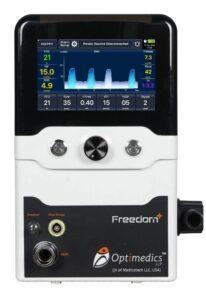
Freedom+ is a non-invasive medical ventilator designed by Optimedics LLP, India’s leading medical device company. This versatile device, developed in collaboration with Medicoteck LLC from the USA, offers multiple therapies for different age groups. Its electronic blending technology ensures accurate delivery of Fio2, flow, and pressures through precise sensors and valves, while the high-resolution graphics display provides real-time measurements for effective patient monitoring. Equipped with therapy disruption alarms, it prioritizes patient safety. The user-friendly interface allows easy operation, making it an ideal choice for hospitals, clinics, and home use in South Africa, Nigeria, and Kenya.
Elisa 300
Elisa 300 manufactured by BPL Medical Technologies Private Limited is a universal ventilator that combines the benefits of a compact design with the performance capabilities required for invasive and non-invasive respiratory therapy. It is suitable for mask ventilation and offers versatile interfaces for PDMS, NO systems, and monitoring equipment. The Elisa 300 features a 12.1-inch high-resolution color touchscreen display, Weaning Analyzer©, an integrated pneumatic drug nebulizer, and a two-hour battery operation. Optional features include a mesh nebulizer interface, etCO2 monitoring, and an integrated cuff pressure monitor.
MAX PROTON PLUS
MAX PROTON PLUS, developed by MAX Meditech Pvt. Ltd. (formerly A.B. Industries), is a ventilator that offers a comprehensive range of modes to cater to various patient needs. It provides basic modes for paralyzed, passive, or active patients, along with advanced modes such as Auto Modes, Spontaneous Modes, and Advanced Modes for complex cases. MAX PROTON PLUS prioritizes patient safety and backup ventilation, offering non-invasive modes for rapid ventilatory support before intubation and easy extubation weaning. It is designed for durability and minimum parts replacement between patients, making it cost-effective and suitable for harsh operating conditions. The ventilator provides precise control over parameters such as pressure, volume, and flow while monitoring crucial variables like airway pressure, tidal volume, and oxygen concentration.
Transvent
Transvent developed by Medion Healthcare Pvt. Ltd. is a Class III transport ventilator designed for electronic control and pneumatic drive. Weighing only 3.4 kg and equipped with an inbuilt battery, this lightweight ventilator ensures portability and convenience during patient transportation. It features a touch screen with a TFT display and offers several modes for respiratory support.
SkanRespiro Plus
SkanRespiro Plus, developed by Skanray Technologies Ltd., is a versatile ventilator designed to provide clinicians with flexible control over a patient’s ventilatory status. It is suitable for both invasive and non-invasive applications, making it ideal for pediatric and adult ICU settings. The ventilator features an advanced compressor design and offers volume and pressure-controlled breath types. It includes an in-built nebulizer port, four-hour battery backup, and seamless integration with Skanray’s Pranaa Medical Air Compressor.
Conclusion
Medical ventilators play a crucial role in respiratory care, offering vital support to individuals with compromised breathing. Whether it’s invasive or non-invasive ventilators, these devices have revolutionized patient care and saved numerous lives. We have explored their functionalities, benefits, and applications, emphasizing the importance of ventilator support in intensive care units for patients with severe respiratory conditions. Proper cleaning, maintenance, and troubleshooting are essential for optimal performance and patient safety. Additionally, platforms like Medzell are driving innovation by promoting medical devices, including ventilators, in emerging markets. With ongoing advancements in technology, the future of ventilators holds great promise in shaping the landscape of respiratory care and improving patient outcomes. Medical ventilators continue to be invaluable tools, providing critical respiratory support and contributing to the well-being of individuals worldwide.
